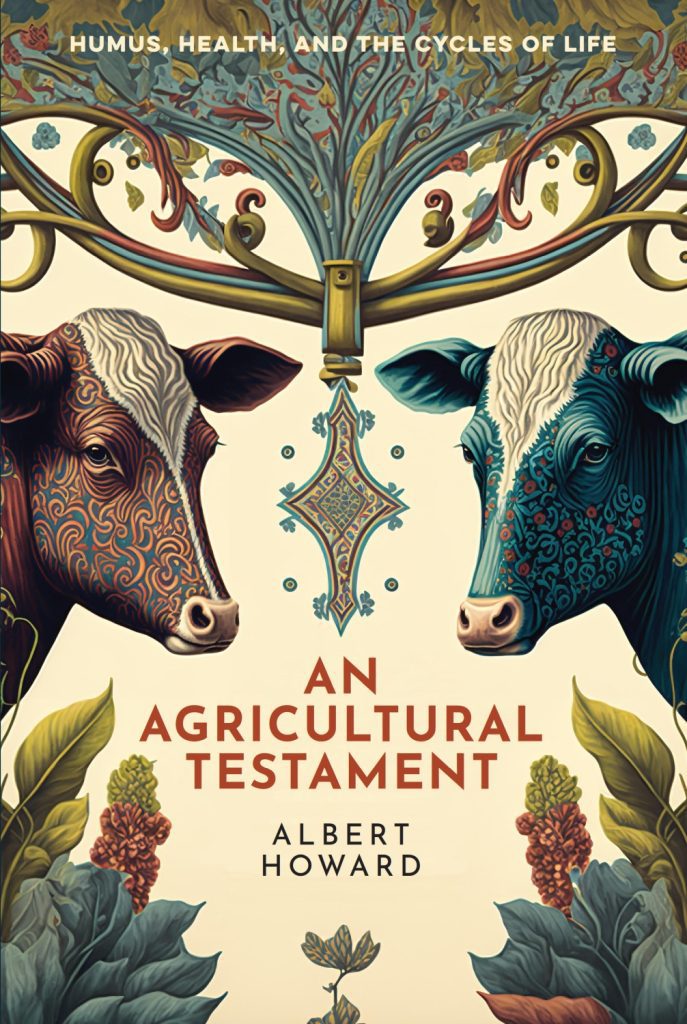
HARDBACK ON AMAZON | US | UK | Germany | France | Spain | Italy | Netherlands | Japan | Canada | Australia
HARDBACK ELSEWHERE | Barnes&Noble |
PAPERBACK ON AMAZON | US | UK | Germany | France | Spain | Italy | Netherlands | Poland | Sweden | Japan | Canada | Australia
PAPERBACK ELSEWHERE | Book Depository | IndieBound | Barnes&Noble | AbeBooks | Fishpond
EBOOK HERE | PDF
DOWNLOAD SAMPLE PDF
“On reading An Agricultural Testament, I was affected so profoundly that I could not rest until I purchased a farm. The reading of this great book showed me how simple the practice of the organic method could be.”
– J. Rodale
WHY IS THERE A COW on the cover of this book? This is a book about agriculture, both traditional and regenerative, and farm animals have become unfashionable in some quarters. Cows, it turns out, are responsible for global warming, climate change, and so, no doubt, rising sea levels and chemtrails.
But any real farmer, from any time in history, knows that this is not true. Animals have been around forever. Animals are a vital part of an insanely complex living system. Anyone who knows the basics of regenerative agriculture understands this.
Albert Howard spent years studying and using the methods of traditional Asian agriculture, and shows in this book that the fertility and health of the soil depend on humus, in the production of which animal materials play an vital role. A healthy soil needs animal inputs. Animals in agriculture are central; they’re right in there with fungi.
This message is not welcomed by those who would feed the modern world a diet of plant-based, lab-grown food substitutes that have lists of ingredients as long as your arm, and are going to save the planet using gene-spliced soybeans and 3D printed pizzas.
So, the cow and her calf are on the cover to redress the balance, and also to feature as one of the stars of this book (along with sugar cane, waste pits, and public servants). She was the photogenic one.
Albert Howard’s text has been thoroughly re-edited in this new version of his book. The habit, common at the time, of using long paragraphs is not preferred by modern readers, so the text has been extensively ‘reparagraphed’. Grammar has been tweaked, and styles have been adopted. Headings have been added, infinitives unsplit.
The changes made have been to make things more comfortable for modern eyes and tastes. The sense and intention of the author has not been altered at all, of course. We hope that Albert Howard would approve of this reworking of his book. His ideas are more important than ever.
Wendell Berry wrote in The Last Whole Earth Catalog:
“Howard’s discoveries and methods, and their implications, are given in detail in An Agricultural Testament. They are of enormous usefulness to gardeners and farmers, and to anyone who may be interested in the history and the problems of land use. But aside from its practical worth, Howard’s book is valuable for his ability to place his facts and insights within the perspective of history. This book is a critique of civilisations, judging them not by their artefacts and victories, but by their response to the sacred duty of handing over to the next generation, unimpaired, the heritage of a fertile soil.”
Contents
Introduction
- Nature’s methods of soil management
- The agriculture of the nations of the past
- The practices of the East
- The agricultural methods of the West
Soil Fertility and Agriculture
- 1.1 The nature of soil fertility
- 1.2 The restoration of fertility
The Indore Process
- 2.1 The Indore Process.
- The raw materials needed – Pits versus heaps – Charging the heaps or pits – Turning the compost – The storage of humus – Output
- 2.2 Practical applications of the Indore Process.
- Coffee – Tea – Sugar cane – Cotton – Sisal – Maize – Rice – Vegetables – Vine
- 2.3 Developments of the Indore Process.
- Green-manuring – The safeguarding of nitrate accumulations – The production of humus – The safeguarding of nitrates and the manufacture of humus – The reform of green-manuring
- 2.4 Grassland management.
- 2.5 The utilisation of town wastes.
Health, Indisposition, and Disease in Agriculture
- 3.1 Soil aeration.
- The soil aeration factor in relation to grass and trees – The root system of deciduous trees – The root system of evergreens – The harmful effect of grass – The effect of aeration trenches on young trees under grass – The cause of the harmful effect of grass – Forest trees and grass – The aeration of the subsoil
- 3.2 Diseases of the soil.
- Soil erosion – The formation of alkaline land
- 3.3 The retreat of the crop and the animal before the parasite.
- Humus and disease resistance – The mycorrhizal association and disease – The investigations of tomorrow
- 3.4 Soil fertility and national health.
Agricultural Research
- 4.1 Current agricultural research.
- 4.2 An example of successful agricultural research.
Appendices
- 5.1 Compost manufacture on a tea estate in Bengal
- 5.2 Compost making at Chipoli, Southern Rhodesia
- 5.3 The manufacture of humus from the wastes of the town and the village
Albert Howard

Nineteenth-century farmers and market gardeners had much practical knowledge about using manures and making composts that worked like fertilizers, but little was known about the actual microbial process of composting until our century. As information became available about compost ecology, one brilliant individual, Sir Albert Howard, incorporated the new science of soil microbiology into his composting and by patient experiment learned how to make superior compost
During the 1920s, Albert Howard was in charge of a government research farm at Indore, India. At heart a Peace Corps volunteer, he made Indore operate like a very representative Indian farm, growing all the main staples of the local agriculture: cotton, sugar cane, and cereals. The farm was powered by the same work oxen used by the surrounding farmers. It would have been easy for Howard to demonstrate better yields through high technology by buying chemical fertilizers or using seed meal wastes from oil extraction, using tractors, and growing new, high-yielding varieties that could make use of more intense soil nutrition. But these inputs were not affordable to the average Indian farmer and Howard’s purpose was to offer genuine help to his neighbors by demonstrating methods they could easily afford and use.
Read more at Backyard Gardening.
‘Artificial manures lead inevitably to artificial nutrition, artificial food, artificial animals and finally to artificial men and women.’
– Albert Howard

Be the first to comment